View in other NatureServe Network Field Guides
NatureServe
Montana
Utah
Wyoming
Idaho
Wisconsin
British Columbia
South Carolina
Yukon
California
New York
Columbia River Redband Trout - Oncorhynchus mykiss gairdneri
Other Names:
Interior Redband
State Rank Reason (see State Rank above)
Species historically occurred across a moderately sized portion of northwestern Montana, but is hybridizing with nonnative trout across almost all of its range. Few populations of pure stock exists, but those that do appear to be stable. Species is threatened by ongoing loss of genetics and habitat loss due to warming water temperatures.
General Description
Columbia River Redband Trout are a native trout of western North America. There is considerable variation in the life history in this group of trout. Resident stream populations are found throughout the Columbia River basin. A lake variation known as Kamloops are found in some larger lakes in the Columbia and Frasier River (British Columbia) basins. A third variation is the steelhead that migrated from the ocean as far as the upper Snake River, Idaho (almost 1000 miles) (Behnke 1992).
For a comprehensive review of the ecology, conservation status, threats, and management of this and other Montana fish species of concern, please see
Montana Chapter of the American Fisheries Society Species of Concern Status Reviews.Diagnostic Characteristics
Characteristics vary considerably among populations of Montana's stream-resident Columbia River Redband Trout, but generally they can be differentiated from the non-native Coastal Rainbow Trout by larger more rounded spots, parr marks that tend to remain into adulthood and are more orange-red around the lateral line surrounded by greenish-yellow, rather than pink-red around the lateral line surrounded by dark green and silver like Coastal Rainbow Trout. Columbia River Redband Trout also have very distinct white tips on the anal, dorsal and pectoral fins.
Species Range
Montana Range
Range Descriptions
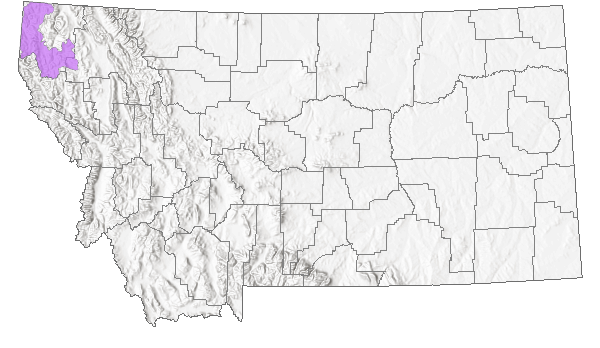
 Native
Native
Western Hemisphere Range
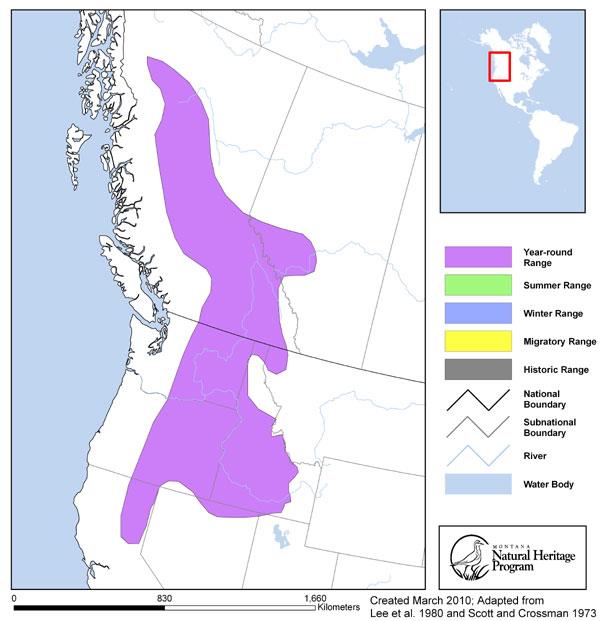
Range Comments
The Columbia River redband trout (Oncorhynchus mykiss gairdneri) is native to the Fraser and Columbia River drainages east of the Cascade Mountains upstream to barrier falls on the Pend Oreille, Spokane, Snake and Kootenai rivers in Idaho, Oregon, Washington and Montana.
Observations in Montana Natural Heritage Program Database
Number of Observations: 134
(Click on the following maps and charts to see full sized version)
Map Help and Descriptions
Relative Density
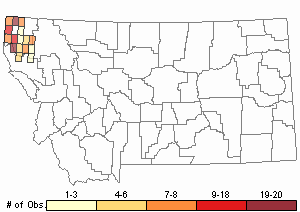
Recency
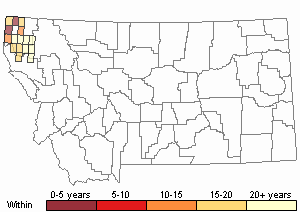
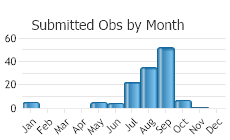
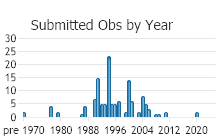
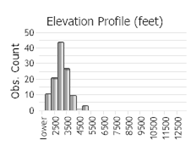 (Observations spanning multiple months or years are excluded from time charts)
(Observations spanning multiple months or years are excluded from time charts)
Migration
Columbia River Redband Trout are typically a stream-resident fish that make short spawning migrations either in the same stream or often into smaller tributaries.
Habitat
Columbia River Redband Trout prefer cool, clean, relatively low gradient streams but, in some circumstances, are able to withstand wider temperature variations than their cousins the Westslope Cutthroat Trout.
Food Habits
Interior Columbia River Redband Trout feed mainly on aquatic insects but eat what is available to them. Large adults also eat fish. River populations are mostly insectivores, while zooplankton and forage fish are important food sources in Lake Koocanusa.
Ecology
Populations of native Columbia River Redband Trout, Westslope Cutthroat Trout and introduced Coastal Rainbow Trout coexist in the Kootenai River drainage. Interestingly, Columbia River Redband Trout have hybridized with Westslope Cutthroat Trout in some drainages and these crosses are considered to be naturally occurring and historic. Hybridization between Columbia River Redband Trout and Coastal Rainbow Trout, on the other hand, is considered to be a danger to the continued existence of Columbia River Redband Trout.
Reproductive Characteristics
Columbia River Redband Trout reach sexual maturity in 2 to 3 years. They spawn from late April through mid-June, depending on water temperatures. The fry typically emerge from the gravel in mid-July.
Management
Long-term conservation and management of this subspecies will require state and federal agencies to develop a comprehensive plan to protect and restore redband trout throughout their native range in Montana. One objective should be to develop a wild brood stock for reintroductions throughout the Kootenai River drainage.
Stewardship Responsibility
Threats or Limiting Factors
Land and water use practices, habitat loss, over harvest, hybridization and a geographical restricted range are leading factors contributing to the decline of redband trout abundance, distribution and genetic diversity in the Columbia River basin (Williams et al. 1989; Behnke 1992).
References
- Literature Cited AboveLegend:
 View Online Publication
View Online Publication Behnke, R.J. 1992. Native trout of western North America. Bethesda, MD: American Fisheries Society Monograph 6. pp. 175-178.
Behnke, R.J. 1992. Native trout of western North America. Bethesda, MD: American Fisheries Society Monograph 6. pp. 175-178. Lee, D.S., C.R. Gilbert, C.H. Hocutt, R.E. Jenkins, D. E. McAllister, J. R. Stauffer, Jr. 1980. Atlas of North American freshwater fishes. North Carolina State Musuem of Natural History. 867 p.
Lee, D.S., C.R. Gilbert, C.H. Hocutt, R.E. Jenkins, D. E. McAllister, J. R. Stauffer, Jr. 1980. Atlas of North American freshwater fishes. North Carolina State Musuem of Natural History. 867 p. Scott, W.B. and E.J. Crossman. 1973. Rainbow trout, Kamloops trout, Steelhead trout Salmo gairdneri Richardson. pp. 184-191. In: Freshwater fishes of Canada. Ottawa, Canada: Fisheries Research Board of Canada, Bulletin 184. 966 p.
Scott, W.B. and E.J. Crossman. 1973. Rainbow trout, Kamloops trout, Steelhead trout Salmo gairdneri Richardson. pp. 184-191. In: Freshwater fishes of Canada. Ottawa, Canada: Fisheries Research Board of Canada, Bulletin 184. 966 p.
- Additional ReferencesLegend:
 View Online Publication
View Online Publication
Do you know of a citation we're missing? Antonelli, A.L., R.A. Nussbaum and S.D. Smith. 1972. Comparative food habits of four species of stream-dwelling vertebrates (Dicamptodon ensatus, D. copei, Cottus tenius, Salmo gairdnei) Northwest Science 46: 277-289.
Antonelli, A.L., R.A. Nussbaum and S.D. Smith. 1972. Comparative food habits of four species of stream-dwelling vertebrates (Dicamptodon ensatus, D. copei, Cottus tenius, Salmo gairdnei) Northwest Science 46: 277-289. Fausch, K.D. 1992. Life as a trout, predator. Trout Magazine Winter 1992. pp. 63-74
Fausch, K.D. 1992. Life as a trout, predator. Trout Magazine Winter 1992. pp. 63-74 Joslin, Gayle, and Heidi B. Youmans. 1999. Effects of recreation on Rocky Mountain wildlife: a review for Montana. [Montana]: Montana Chapter of the Wildlife Society.
Joslin, Gayle, and Heidi B. Youmans. 1999. Effects of recreation on Rocky Mountain wildlife: a review for Montana. [Montana]: Montana Chapter of the Wildlife Society. Perkinson, R.D. 1993. Status of the Fsc Redband Trout (Onchorhynchus Mykiss Gairdneri) in Montana. Libby, MT: Kootenai National Forest Mt-American Fisheries Society -MT Chap. Fishes of Specieal Concern Committee. 9 p.
Perkinson, R.D. 1993. Status of the Fsc Redband Trout (Onchorhynchus Mykiss Gairdneri) in Montana. Libby, MT: Kootenai National Forest Mt-American Fisheries Society -MT Chap. Fishes of Specieal Concern Committee. 9 p. Sylvester, R. and B. Marotz. 2006. Evaluation of the Biological Effects of the Northwest Power Conservation Council's Mainstem Amendment on the Fisheries Upstream and Downstream of Hungry Horse and Libby Dams, Montana. Montana Fish, Wildlife, and Parks Annual Report prepared for U.S. Department of EnergyBonneville Power Administration. Bonneville Power Administration Project No. 2006-008-00 Contract No. 28350. 124 p.Contract No. 28350
Sylvester, R. and B. Marotz. 2006. Evaluation of the Biological Effects of the Northwest Power Conservation Council's Mainstem Amendment on the Fisheries Upstream and Downstream of Hungry Horse and Libby Dams, Montana. Montana Fish, Wildlife, and Parks Annual Report prepared for U.S. Department of EnergyBonneville Power Administration. Bonneville Power Administration Project No. 2006-008-00 Contract No. 28350. 124 p.Contract No. 28350 Sylvester, R. and B. Stephens. 2011. Evaluation of the physical and biological effects of the Northwest Power Conservation Council's Mainstem Amendment upstream and downstream of Libby Dam, Montana. Libby, MT: Montana Fish, Wildlife, and Parks Annual Report prepared for U.S. Department of Energy Bonneville Power Administration. Bonneville Power Administration Project No. 2006-008-00, Contract Nos. 43309 and 48555. 282 p.
Sylvester, R. and B. Stephens. 2011. Evaluation of the physical and biological effects of the Northwest Power Conservation Council's Mainstem Amendment upstream and downstream of Libby Dam, Montana. Libby, MT: Montana Fish, Wildlife, and Parks Annual Report prepared for U.S. Department of Energy Bonneville Power Administration. Bonneville Power Administration Project No. 2006-008-00, Contract Nos. 43309 and 48555. 282 p. Sylvester, R., A. Steed, J. Tohtz, and B. Marotz. 2008. Evaluation of the Biological Effects of the Northwest Power Conservation Council's Mainstem Amendment on the Fisheries Upstream and Downstream of Hungry Horse and Libby Dams, Montana. Montana Fish, Wildlife, and Parks Annual Report prepared for U.S. Department of EnergyBonneville Power Administration. Bonneville Power Administration Project No. 2006-008-00 Contract No. 28350. 124 p.Contract No. 28350
Sylvester, R., A. Steed, J. Tohtz, and B. Marotz. 2008. Evaluation of the Biological Effects of the Northwest Power Conservation Council's Mainstem Amendment on the Fisheries Upstream and Downstream of Hungry Horse and Libby Dams, Montana. Montana Fish, Wildlife, and Parks Annual Report prepared for U.S. Department of EnergyBonneville Power Administration. Bonneville Power Administration Project No. 2006-008-00 Contract No. 28350. 124 p.Contract No. 28350
- Web Search Engines for Articles on "Columbia River Redband Trout"
- Additional Sources of Information Related to "Fish"





